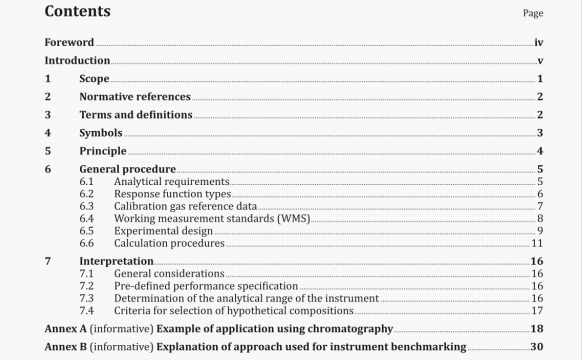ISO 10723 pdf download – Natural gas – Performance evaluation for analytical systems.
The response functions above are shown in a form up to third order. However, simpler forms up to second order or simply first order may be considered. Choose the form of the response functions with the following considerations:
a) the simplest form that gives an adequate fit to the data should be used to avoid ovcr-paramctcrizing the response function;
b) the number of calibration points, and hence the number of reference gases required to satisfactorily describe a polynomial. increases with the order I the function (see 6.4.2);
c) if there is an a priori reason to assume that a lower-order polynomial will always be suitable, then this should be chosen and a lower number of reference gases may be used (see 6.4.2).
6.3 Calibration gas reference data
6.3.1 General considerations
The performance benchmarks from this evaluation procedure are calculated for the Instrument used in combination with the proposed/current calibration gas mixture. This is the working calibration gas used for routine, often daily, calibration.
NOTE The design of the calibration gas mixture can have significant influence on the distribution of bias errors for the instrument. Similarly, the uncertainties on the amount fraction of each component in the calibration gas can make a significant contribution to the uncertainty on the measurement results. Hence, the design and uncertainty of composition of the calibration mixture shall be chosen carefully.
6.3.2 ComposItion and uncertainty
The amount traction, XjI, and standard uncertainty, U(X,,,5I), tor each component in the calibration gas mixture shall be obtained or derived from the certificate of calibration.
II the uncertainty quoted on the certificate is not a standard uncertainty (k = 1), then the standard uncertainties shall be derived using the manufacturer’s stated coverage factor.
The WMS should be chosen so as to be suitable for the intended analytical application as discussed in 6.1. However, it is not practicable to manufacture and calibrate WMSs which contain all the components in natural gas, given the complexity of the higher hydrocarbons that are commonly found and the difficulty of preparing high-quality mixtures containing condensable components. In the ma)ority of applications, the major components in natural gas, nitrogen, carbon dioxide, methane, ethane, propane. 2-methyipropane (iso-butane) and n-butane are generally specified and normally included in the reference gas mixtures. In addition, 2-methylbutane (iso-pentane), n-pentane and a representative C6. component such as n-hexane are often Included. If 2,2-dimethylpropane (neo-pentane) is a specified component in the analytical requirement, it may also be included in the WMS. Any component expected to be present in an amount fraction greater than 0,01 should be included.
NOTE The VMS used in this evaluation procedure can also be used to define the analysis function of an analyser when it is initially installed or on other occasions when a primary calibration Is required to define the analysis function assumed by the Instrument’s data system.
6.4.2 ComposItion and uncertainties
For each specified component that will be included in the WMS, the number of levels, calibration points, at which the evaluation shall be performed depends upon the form of the function type selected for the evaluation (see 6.2.2).
The minimum number of calibration points recommended to give sufficient degrees of freedom for the unbiased estimate of the response function Is as follows:
3 (three) for a first-order polynomial;
5 (live) for a second-order polynomial:
7 (seven) for a third-order polynomial.
The WMSs shall be selected such that their amount fractions are approximately equally spaced across the defined evaluation range (see 6.1.3) with one at (or below) the lower limit and one at (or above) the higher limit.
NOTE 1 Depending on the intended application, the lower end of the range might be close to the limit of detection, in which case It might not be possible to Include a component amount fraction below the lower end of the application range
In the design of the recipe of the set of WMSs, the user shall be careful not to include all high-amount fractions oIthe higher hydrocarbons together in the same mixture. Should this be the case, the pressure of the mixture would be limited due to the potential of retrograde hydrocarbon condensation due to the high dewpoint of the mixture. The higher amounts of higher hydrocarbons should, where possible, be distributed amongst the set of WMSs.
Once designed and manufactured, the composition and uncertainties of the WMS should be determined by a comparison method in accordance with ISO 6143. Certified reference gas mixtures (CRMs) of an appropriate metrological quality shall be used as the source of traceability for this comparison step. Whether binary or multi-component mixtures are used.
ISO 10723 pdf download – Natural gas – Performance evaluation for analytical systems
